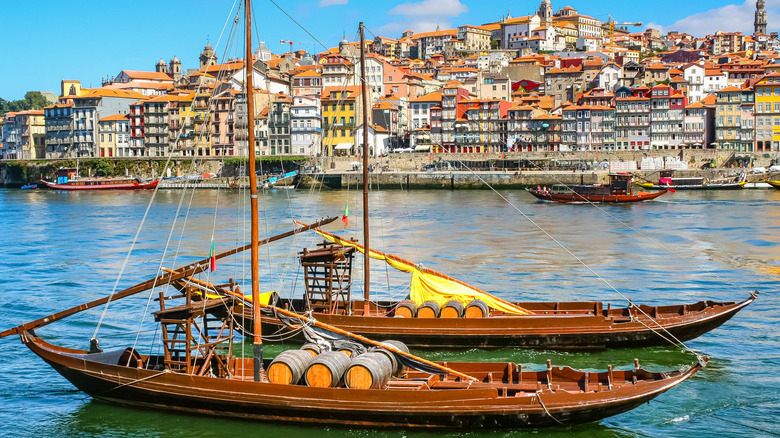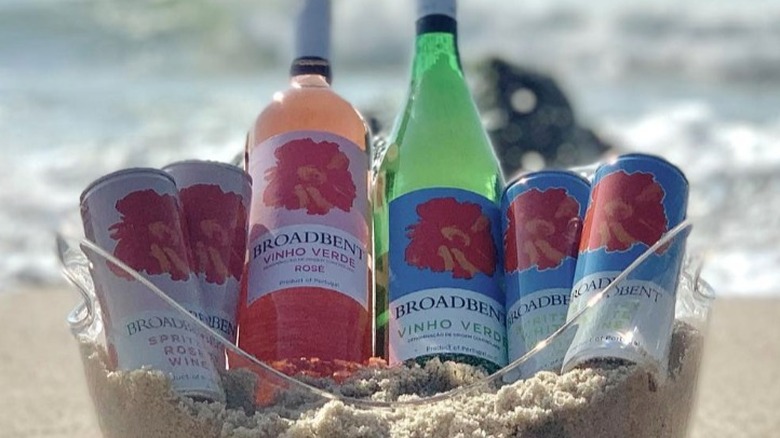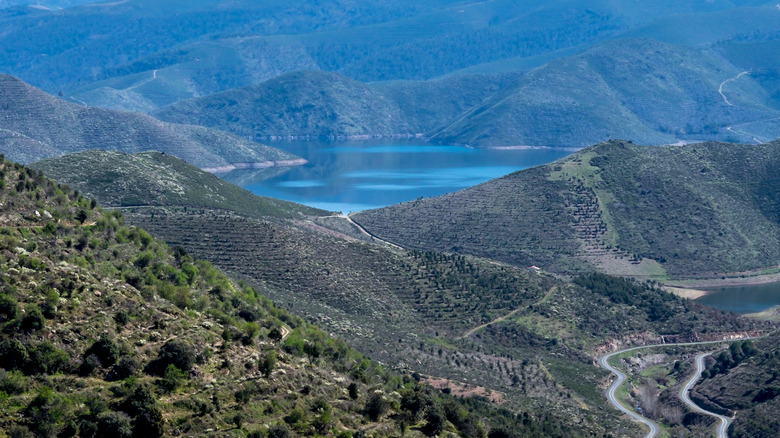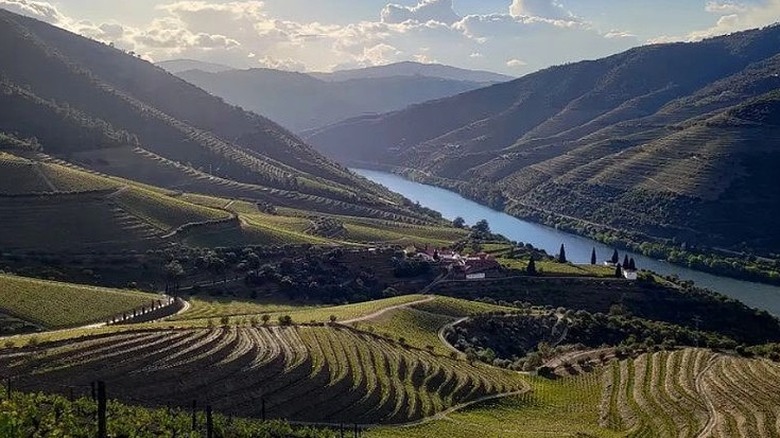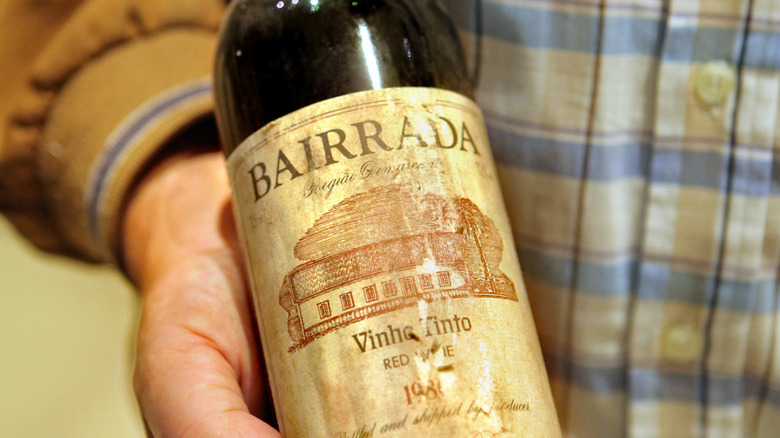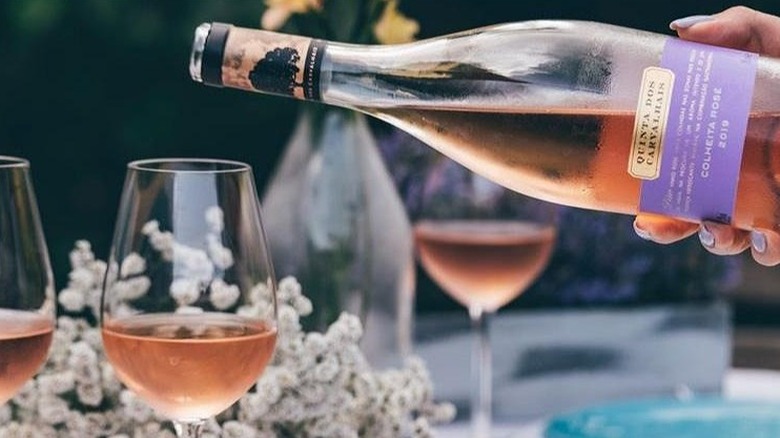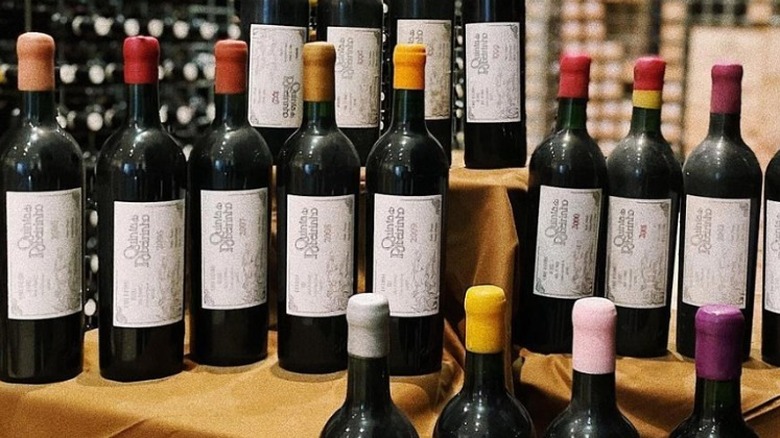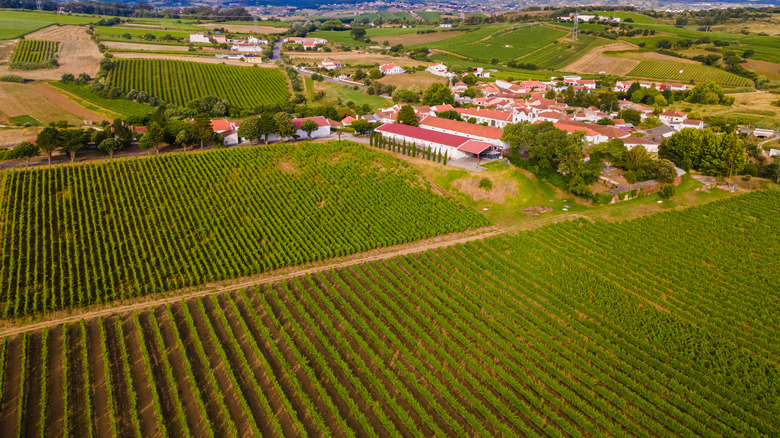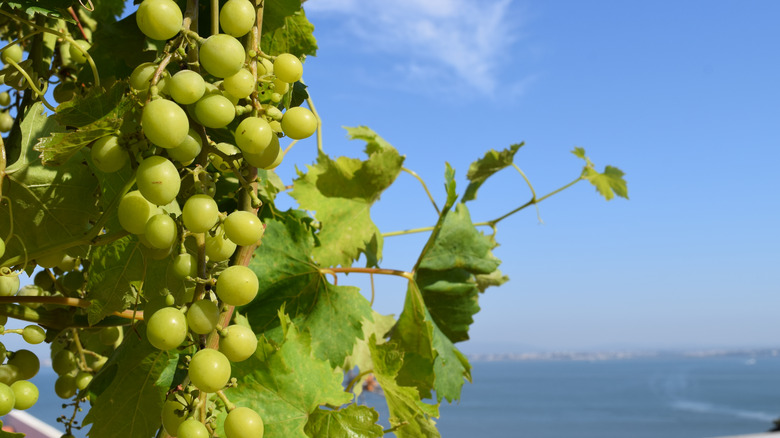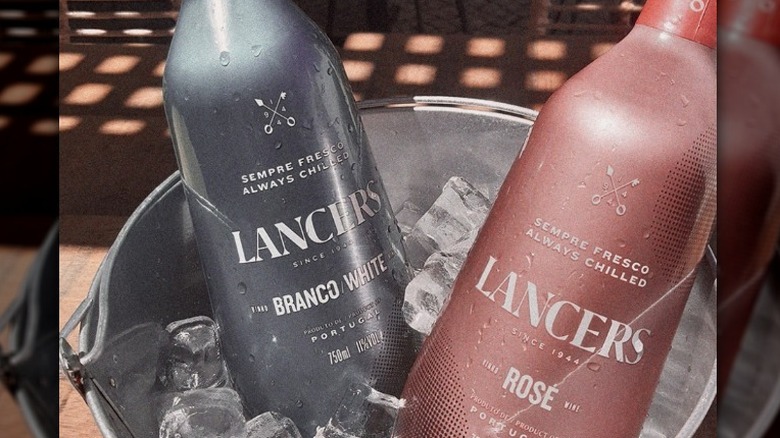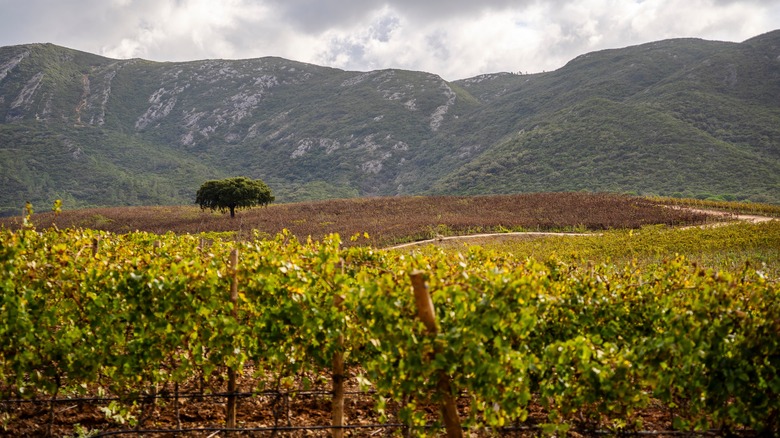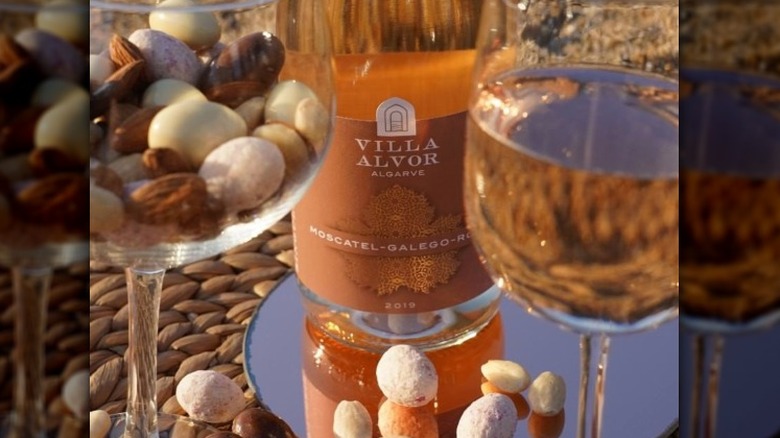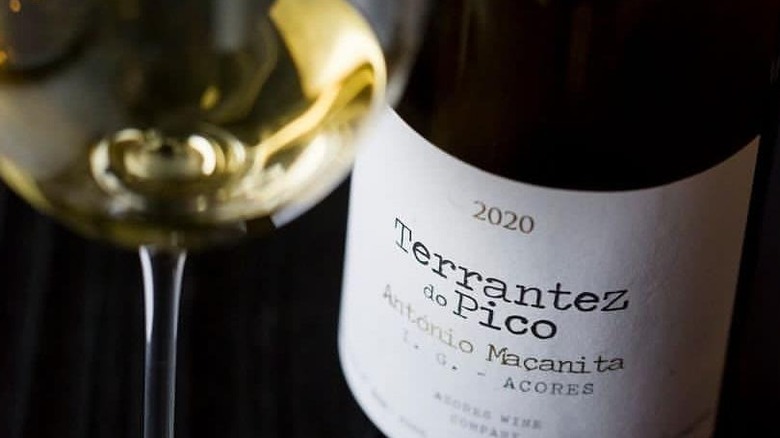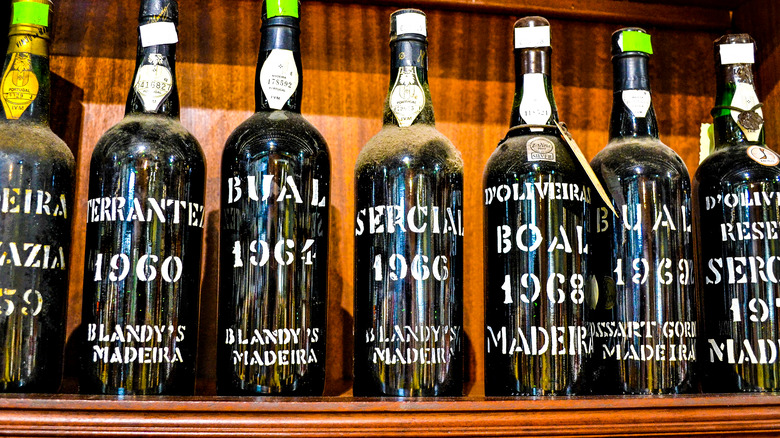Explore Portugal With These 13 Wine Regions
Portugal is known for its rugged coastline, sandy beaches, ancient blue-tiled cities, and tropical islands that offer some of the world's best surfing, sailing, and deep-sea fishing. There are a host of delectable foods you have to try when visiting Portugal, but the country is world famous for its incredible wines. According to reporting from the USDA Foreign Agricultural Service, Portugal has 192,743 hectares of land under vine. And, the country boasts more than 250 native varietals (via the Wine Industry Network).
The size of Indiana, Portugal's western and southern coasts abut the Atlantic Ocean, and its northern and eastern borders are shared with Spain. Bisected by the Tagus River and capital city Lisbon, the country has distinctly unique northern and southern regional cultures. The north is cooler and rainier than the sun-seared south, even seeing snow on Serra da Estrela, a mountain peak in the country's northeastern corner. To the west is Porto, the second-largest city and the cornerstone of Portugal's most famous wine region, renowned for elegant, bold still wines and lush fortified wines aptly called port. The hot and sunny south is drenched with densely flavored rustic red wines, herbal and fruity rosés, and tangy tropical white wines.
Wine Tourism reports Portugal has been making wine for 4000 years from every cardinal direction. Each region is protected with designations called Indicações Geográficas Protegidas (I.G.P.) or Denominação de Origem Controlada (D.O. and D.O.C.) that ensure regional standards and tradition.
Northwest: Vinho Verde
Vinho Verde, in the northwest corner of Portugal, borders the Atlantic Ocean to the west and the Galicia region of Spain to the north. (Close enough to explore Spain's wines as well, if you plan it right.) This region is known for its cool, often rainy climate, and its maritime influences.
Vinho Verde, which means green wine and indicates a youthful age, not the color, isn't the only style produced in the region, but it is the most sought out. Why? Because of its tangy fruit-forward flavors and refreshing effervescence. Lemony white Vinho Verde is commonly found during the summer months, but rosés and reds are produced here too. These incredibly food-friendly wines make perfect picnic and patio wines in the hot summer months.
Broadbent Selections makes a gorgeous white Vinho Verde that comes in 750-milliliter bottles and ready-to-drink cans that have notes of lemon zest, crunchy green apple, and tangerine. The company's rosé smells and tastes like watermelon juice and rose petals. Red Vinho Verde is also commonly produced but rarely exported. Brands like Adega de Monção craft a soft and fruity red with notes of raspberry and red plum.
North-central: Trás-os-Montes
Tiny Trás-os-Montes is a remote wine region situated in the mountainous northern reaches of Portugal just along the Spanish border. According to Wine Tourism in Portugal, Trás-os-Montes' Transmotano Denominação de Origem (D.O.), has three small sub regions called Chaves, Valpaços, and Planalto Mirandês. The region and subregion are known for light and aromatic, often herbal, white, and red wines.
Since 1942, winemakers Mateus have produced effervescent white, red, and a notorious semi-sweet frizzante rosé wine. Known for its short oblong sphere-shaped bottle and its salmon pink color, Mateus is equally famed as the favorite wine of rock stars, astronauts, the literati, Steve Jobs, and England's Queen Elizabeth and the late Princess Margaret.
Aside from Mateus, few wines from Trás-os-Montes are exported, but there are some fantastic producers. Try Casa do Joa's Alto do Joa wine range for a robust yet elegant style, mouth-watering acidity, and firm structured red wine. Casa do Joa makes various white, red, and rosé wines. Alto do Joa red wines are substantial and flavorful and stand up to meat dishes, pasta, pizza, and roasted vegetables. In contrast, its white wines are floral and delicate and pair perfectly with seafood, oysters, quiche, and sushi. Similarly, pale salmon-pink rosés are fruit-forward with notes of rose petals, raspberry, plum, citrus, and saline on the finish, yet it is light and pleasantly refreshing. Try it with charcuterie, salmon, and brunch fare.
North-central and northeast: Douro Valley
Perhaps the most famous wine region in all of Portugal is the Douro Valley, with its steep, terraced vineyards flanking the Douro River. This area is legendary for its robust fortified port wines. Iconic brands like Warre, Dow's, Graham's, and Ferreira date back hundreds of years and dominate the market with lush ports.
Just what is a fortified wine? Wines of Portugal explains that port is created by adding grape brandy (liqueur) to a batch of wine during fermentation, stopping the process and preserving varying levels of sweetness from the unfermented grapes. Port comes in ruby, late-bottled-vintage, tawny, white, and on rare occasions, rosé. Wine Enthusiast champions rare white ports; if you haven't tried them, we recommend seeking them out. White port is fresh, with bright acidity and complexity rarely reached by other white wines.
Red grapes touriga nacional and touriga franca are kings in the Douro Valley, where they don't only make fortified wines. Regional table wines are increasingly popular in this ancient wine region. You should drink port after meals in lieu of desert or with freshly cracked nuts, blackberry tarts, or plum cake. Port is one of the only wines that can stand up to milk and dark chocolate.
Check out Symington Family Estates, which has been producing wines for more than a century in the Douro Valley. Quinta de Vesuvio, founded by the iconic Dona Antónia Adelaide Ferreira, is one of today's prized producers of ports and rich reds.
Central-west Bairrada
Bairrada isn't quite along the west coast of Portugal, but its vineyards are close to the ocean. The region is home to the once capital of the country, Coimbra, and some of the oldest vineyards in the country (via Wine Tourism in Portugal). Aside from using native grapes to craft their wines, winemakers in Bairrada experiment with international varietals like pinot noir, cabernet sauvignon, syrah, and chardonnay. Bairrada is a breadbasket agricultural manse for Portugal. The wines from Bairrada are full-flavored, ample-bodied, and aromatic with ripe fruit, herbs, and woodsy notes.
Niepoort Family Estates owns several wine properties in Portugal. The maker's Redoma Reserva Branco comes from a tiny vineyard with very old vines, which leads to grapes with concentrated flavors, and aromas. The property also produces fruity, robust reds and lush rosé wines. For something different, look for Drink Me Nat Cool, a fresh, light, lower alcohol wine made for easy drinking at picnics, barbeques, or on a lazy Sunday afternoon at the pool.
Central-middle: Dão
The Dão is an ancient wine region focusing on native grapes, such as touriga nacional and tinta roriz. The latter is genetically identical to Spain's tempranillo grape. The region is nestled in the center of the northern sector of Portugal, just below Vinho Verde and the Douro Valley. The Vogue River meanders through its midsection providing a cooling effect and adding rich minerals to the soil. Wine Tourism in Portugal states that the Dão is a gastronomic center known for its cheeses, presunto (cured ham), and agricultural products. Aside from touriga nacional, native grapes like baga, bastardo, and bical thrive in the region leading to aromatic, flavorful, rich wines that have developed acidity and structure. Wines from this region used to be of tremendous value, yet inexpensive, but recently, the prices are inching up as they win critical acclaim.
With a very talented woman winemaker at the helm, Beatriz Cabral de Almeida, producer Quinta dos Carvalhais is creating widely-distributed crisp and refreshing white wines, fruity rosé, and elegant yet structured red wines from its vineyards. Pair the rose with seafood, salads, charcuterie, and salty hard cheeses, and you'll have a lush meal with complex contrasting and complementing flavors.
Central-east: Beira Interior
Wine Tourism in Portugal reveals that the rural, rustic, and weathered Beira Interior region near Spain, which stretches from the Tagus river to its south up to Guarda to its north, has been a wine-producing region since the Roman occupation. Beira Interior is surrounded by the Estrela, Marofa, and Malcata mountain ranges, with vineyard elevations ranging from near sea level to jagged peaks nearly a half mile above. Due to its varied climate and geography (covering 160,000 hectares), Beira Interior is capable of producing white, rosé, and red wines along with espumante (sparkling) white and rosé wines.
Look for the legendary producer, Luis Pato, who excels at making quaffable white, rosé, and red wines that are fresh, accessible, and food-friendly easy drinkers. Pato also crafts exceptional, expensive, age-worthy red wines from his parcel of vines, which is part of his family estate. The land was previously owned by his iconic winemaking father, João, and production dates back hundreds of years. The Pato family are considered winemaking rebels because they take risks and have modernized their process. The family's wines are incredible, if you can find them — that is.
Central-west: Lisboa
Lisboa (Lisbon) is the thriving capital city of Portugal. The city of seven hills is just 18 miles inland from the Atlantic coast, situated on the estuary of the massive Tagus River and Sea of Straw. Known as the Portuguese Riviera, the luxurious region is studded with yellow stuccoed buildings bedecked in decorative blue and white Azulejo tiles and topped with orange curved shingles. Lisboa is also a prolific wine region known for its rustic red wines, tangy white wines, and crisp rosés. Lisboeta wines pair perfectly with the region's bright seafood, octopus, grilled sardines, and shrimp omelets.
Lisboa is the country's largest wine-producing region and has nine D.O. subregions. It is one of the oldest European wine areas, having been planted by the Phoenicians who brought vines from Syria as they explored their way to the British Isles (via Wine Tourism in Portugal).
Just west of the city is an ancient micro-subregion of just a few acres called Carcavelos, which produces a legendary nutty, honey-sweet wine with bracing acidity and floral aromatics (via Liquor.com). Carcavelos was a favorite of Thomas Jefferson. With just 12 ½ hectares under the vine, Villa Oeiras is the only public producer crafting this wine. Due to limited quantities, very little Carcavelos are exported. Plenty of wines from the Lisboa regions are available, fortunately. Look for Lourinhã brandies, Quinta do Monte d'Oiro Reserva red wines, and the Adega Viúva Gomes range.
Central-middle: Tejo
Tejo is a vast region in the center of Portugal, just east of Lisboa. It is a primary food-growing region, with fruit and olive orchards, rice farms, and cork oak forests. The Tagus (Tejo) river winds through the fertile area providing nutrients to enrich the rich soil and terroir. It is here that the simplest, easy-drinking wines are produced. Wines of Portugal reports that many of the wines from this region are found in restaurants and bars across the country. As a cost-saving measure, many wines are made by cooperatives rather than estates. The focus in Tejo is on a blend of international and native grapes incorporated to create crowd-pleasing, inexpensive yet flavorful, balanced wines, including white, rosé, and red wines, along with espumante (sparkling) whites and rosé.
Wines to try include Adega Cooperativa do Cartaxo 'Bridão' Tinto Reserva and Fiuza 3 Castas Branco Chardonnay. Fiuza 3 Castas (castas is the Portuguese word for grapes) produces white, red, and rosé blends that are fresh, balanced, and delicious food-friendly wines. Tejo soil breeds grapes that maintain increased natural acidity, leaving you with a vino you're sure to have fun with while drinking.
Southwest: Península de Setúbal
Wine Searcher indicates that the Setúbal peninsula, which is south of the Tagus River and Lisbon and borders the Atlantic Ocean, is perfect for growing grapes. The region is small and flat, with sandy earth and a small mountain range called the Serra da Arrábida that provides gentle slopes rich with clay and limestone soils. The mineral-packed terroir is something that grapes love.
The wines from Setúbal are special and produced with an eye on regional tradition. There are two Denominação de Origem Controlada subregions on the peninsula; One is called Palmela and exists to the northeast, and the other is eponymously known as Setúbal and is set further inland. Palmela is known for its inky, pastoral red wines crafted from the native castelão grape. This D.O.C. is also home to one of Portugal's most famous wines, Lancers, crafted in Palmela since 1944 by José Maria da Fonseca. Setúbal produces a sweet fortified wine from muscat de Alexandria that tastes like candied orange peel, almonds, and honey drizzled over vanilla gelato.
Check out Jose Maria da Fonseca Alambre Moscatel de Setubal, a lush dessert wine with apricot marmalade notes, or Casa Ermelinda Freitas Dona Ermelinda Reserva, a plummy, spicy, woodsy wine made from native castelão grapes; a perfect pairing for wood-fired pizza, roasted meats, and grilled vegetables.
Southeast: Alentejo
The southeastern Alentejo region covers almost a third of the country from the Tagus river to the southern reaches and borders Spain's sunniest region. It is exceptionally hot, dry, and perfect for growing certain heat-loving grape varietals, as it gets over 3,000 hours of sunlight per year (via Wine Traveler). Wines here are brawny and bold with fully developed flavors and a notch higher alcohol content than Portugal's northern vinos. This hot climate doesn't provide for a lot of exports, but the low-grade soil quality studded with schist, granite, and limestone pushes the grapes into developing complex layers of taste.
Herdade do Esporão Reserva produces a wide range of red and white wines from the more than 40 grape varietals they grow in a region most known for its montado ecosystem, which is dense in cork oak forests. The property is one of Portugal's most famous wine producers. Here, orchard fruit, olives, and other fruit and vegetables are grown on a vast estate. Ravasqueira produces a lush syrah-based wine called Guarda Rios Tinto that is full-bodied, spicy, and rich with blackberry and plum notes. Look for floral and fruity white and rosé wines from Ravaqueira too. The Kingfisher bird on the label is a subtle nod to an elegant wine style. Sip Guarda Rios Tinto with regionally crafted creamy sheep cheese, savory duck pies, and filet mignon.
South: Algarve
The Algarve is more famous for its miles of sandy beaches and crashing Atlantic Ocean waves than it is for wine, but amazing wine is crafted here too. Travel & Leisure magazine reports that wines in the Algarve region are flourishing. The balmy climate and long growing season produce ripe and lush grapes that lead to high-octane, fruit-forward, brazen wines. Like those from Alentejo, wines from the Algarve tend to be bold, spiced, and jammy. A combination of searing sun, high heat, and warm winters stress the vines but also results in well-developed sugars and flavors — making wines from these two regions a favorite for exports to consumers worldwide.
Wine Enthusiast lists Aveleda Villa Alvor's Alicante Bouschet and Casa Santos Lima Al-Ria Red amongst its favorites from the region. Aveleda is a top producer from Vinho Verde, now helming a top property at the opposite end of the country to great success. Its wines from the Algarve are highly perfumed yet maintain bright and delectable acidity and fruit accents. Pair the whites with grilled lobster, seared scallops, and savory egg dishes, and for the reds, match them with the best types of meats you can find: Salty cured ham, wild game, salumi pizza, or a thick bolognese.
Islands: Azores
As a coastal country, Portugal claims several islands and archipelagos as its own, like the Azores. The Azores is an archipelago in the Atlantic Ocean comprised of nine major islands and eight minor islands. Terceira, Pico, and Azores are the largest of the nine. The archipelago was discovered by Portuguese explorers in the 15th century, according to World Atlas, which reports that the islands are about 870 miles or two hours from Europe and five hours from South America by airplane. They have volcanic origins leading to mineral-rich, well-draining soils perfect for grape cultivation. The wine regions are some of the oldest vines in the world and are unique in style. In fact, these vines are one of the first wine regions to be protected by UNESCO as part of our collective world heritage.
The Azores produces luscious fortified wines like those from the Azores Wine Company. António Maçanita, Volcanic Series, and Branco Vulcanico each have a lythe salinity with white floral and nutty notes, tropical fruit, and a hint of spice. Look for António Maçanita's Terrantez do Pico; an old vine verdelhos grown in volcanic soil. It has developed peach and apricot notes with hints of ruby red grapefruit, puckery acidity, and pronounced salinity on the lingering finish. Island wines are perfectly paired with seafood, shellfish, and bivalves.
Islands: Madeira
Madeira is a volcanic archipelago including the islands of Madeira, Desertas, and Porto Santo. The largest island, Madeira, is between the Azores and Canary Islands, 325 miles west of Morocco, and 620 miles southwest of Lisbon (via World Atlas). Like Azores, Madeira is a lush agricultural zones built upon rugged land.
Wine Searcher reports that the Madeira archipelago was discovered by seafaring Portuguese explorers in 1419 A.D. The islands were cleared of dense forests and planted with grapevines and sugarcane. The islands became an important stop on the way to the New World colonies in North, Central, and South America. As such, the wines from Madeira were unstable and maderized (cooked) when they crossed the Atlantic Ocean near the equator. To ensure stability, the wines were fortified with grape brandy, creating a one-of-a-kind fortified wine that hails only from the islands.
Blandy's, D'Oliveiras, and Barbeito are amongst the most famous brands. Madeira ranges in style from dry and crisp aromatic wines to sweet dessert styles, but they all maintain a lovely, balancing acidity that is refreshing. There is no better wine to sip wine from Portugal pre- or post-dinner. Madeira wine is a fantastic aperitif with fresh fruit, charcuterie, salty Portuguese sheep cheeses, or succulent seafood.
The thing about Madeira that makes it fantastic is that it can virtually last forever while maintaining freshness and its delicious flavor profile. The United States Revolutionaries toasted the U.S. Constitution with Madeira. Reason enough to give it a try!
